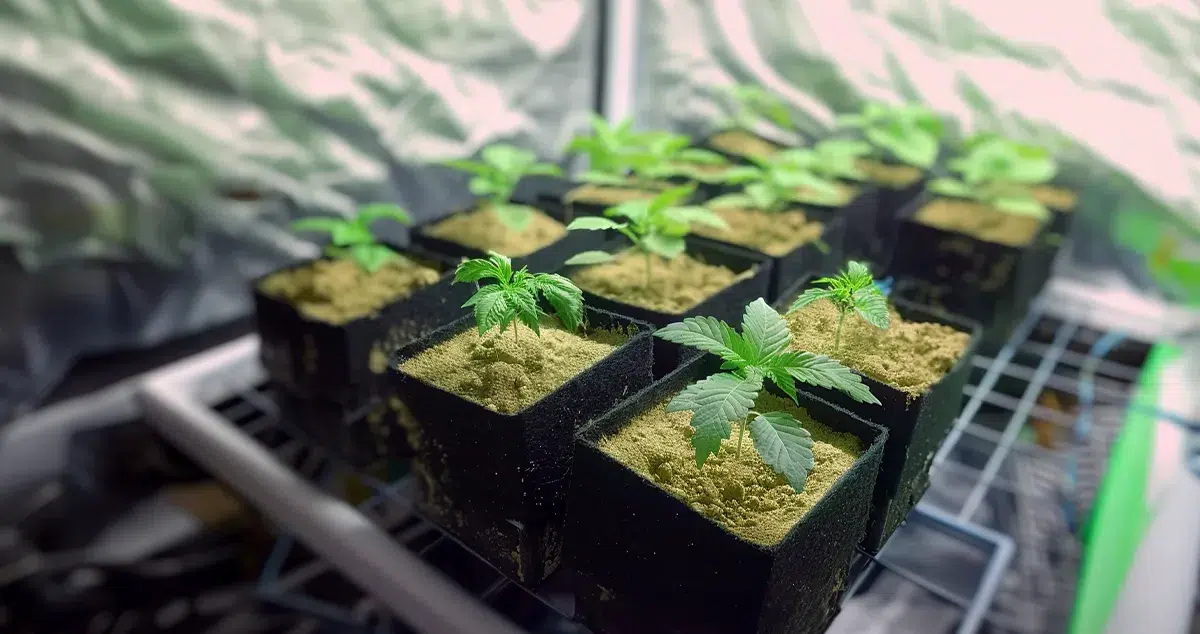When it comes to growing cannabis, several things can quickly take beginner growers out of their comfort zone. One of those is rockwool and usually for all the wrong reasons. You may be asking yourself, is rockwool even safe for cannabis? Can I handle it with my bare hands? What are the risks, and how do I dispose of it?
Well, worry no further, and allow me to eliminate your concerns. I’ll highlight why using rockwool to grow cannabis is ideal. I’ll explain how it is made, its pros and cons, and what to consider from seed to harvest. Plus, I’ll share plenty more to inspire you to try this large-yielding growing medium.
TL/DR
- Rockwool cubes or slabs must be soaked in a pH between 5.5 and 6.5.
- Using rockwool with hydroponic systems results in massive yielding cannabis plants.
- Rockwool contains no nutrients and is classed as a sterile growing medium.
- With such high water retention, rockwool can hold 18 times its weight in water.
- Tomatoes, peppers, strawberries, and melons are commercially grown with rockwool.
- Rockwool can be stored for long periods and is lightweight when dry.
- The pH level of your rockwool should be 5.5 during the vegetative cycle.
- The pH level of your rockwool should be 6.0 during the flowering cycle.
- Rockwool can irritate the skin and eyes in some cases.


What is Rockwool?
Rockwool is a bi-product of heated molten rock, treated with heat and injected with air. The result is a fine wool-like substance capable of holding 18 times its weight in water. It retains lots of oxygen, has excellent drainage, contains no nutrients (inert growing medium), and is sterilized of pathogens. When rockwool is manufactured, it is molded into square blocks or meter-long slabs and will have a light yellow color.


Is Rockwool Safe for Cannabis Cultivation?
To put your mind at rest and quickly extinguish any negative press growing rockwool with cannabis may have, the short and simple answer is absolutely! Commercial-scale farmers produce tomatoes, peppers, herbs, strawberries, and even melons using rockwool cubes and a hydroponic dripper system. Considering that it is a sterile growing medium that contains no bacteria or fungi, you may be stuck to find a better and safer inert growing medium than rockwool.
Pros and Cons of Rockwool for Cannabis Cultivation
Now, by this point, there is a good chance you like what you are reading and are ready to find out all the pros and cons of using rockwool for cannabis cultivation. Below are the reasons why I love to use rockwool and the downsides.
| Pros |
| – Sterile – Sterile growing media are essential in hydroponics because they do not contain living bacteria or organic matter. – Great for Germination – It holds high amounts of water, making it an excellent starting point for cannabis seeds. – Good Drainage – Not only does rockwool hold tremendous amounts of water, it also has equally good drainage and air displacement. – Easy to Transplant – Transplanting a rockwool cube into a large-sized pot, slab, or hydroponic system is easy. – Practicality and Storage – Rockwool is lightweight and can be stored without use for long periods of time. |
| Cons |
| – Not Biodegradable – Unlike soil or coco coir, rockwool is on the non-biodegradable list. – High pH – Rockwool will naturally have a high pH level, closer to 8.0. Buffering is necessary. – Not Sustainable – You cannot recycle or reuse the rockwool after each harvest. – Health Hazard – Dry rockwool fibers in the air can cause irritation to the skin and the lungs. |
Using Rockwool From Germination To Harvest
Don’t worry. I am not about to walk you through the week-by-week process of growing cannabis plants from seed to harvest. For a guide on how to grow cannabis, read Robert Bergman’s Grow Bible.
Below is an overview of what you must consider when becoming a rockwool maestro.
Rockwool Needs to be Soaked in an Acidic Solution Before Use
It would be great if rockwool came pre-soaked and pre-buffered; however, due to the manufacturing process, rockwool’s pH levels are high (pH 8). You’ll need to lower the pH. This means the cubes or slabs must be soaked in a pH solution between 5.5 and 6.5. This is important because nutrient accessibility needs to be at this optimal range when growing with hydroponic methods using rockwool.




Can You Germinate Seeds In Rockwool?
You certainly can do it with incredible germination rates and healthy seedlings! To learn more about the germination side, I encourage you to check out this article about germinating seeds in rockwool, peat, and coco coir.
Cloning Cannabis Cuttings in Rockwool
Even though cloning in Coco Coir Jiffy Plugs is my favorite, I have seen thousands of clones successfully rooted in rockwool. The trick is ensuring your cubes are half dry before inserting the cuttings. This is done by allowing the cubes to sit on a surface until there is no more excess water dripping out the bottom of the cubes. This allows a fine balance between oxygen and water to encourage roots to form on the clones.


Vegetative Stage with Rockwool
Be ready for abundant growth in the root zone that leads to fast, vibrant, healthy crops! The pH level of your rockwool should be closer to 5.5. Normally, a short vegetative period is better suited to compensate for the aggressively fast growth associated with rockwool.
Flowering Stage with Rockwool
Okay, so this is the part that everyone loves to hear: the flowering stage. Are you fed up with mediocre yields? Well, that can be a thing of the past when flowering with rock wool. The pH levels during this stage should be closer to 6.0.
Should I Use Rockwool Blocks or Slabs?
Rockwool can come in different shapes and sizes, from 2-inch, 4-inch, 6-inch cubes to meter-long slabs that are 15 cm wide. You may have seen different hydroponic growers using rockwool cubes on drain tables packed closely together, growers using slabs with 4-inch cubes inserted on the top with dripper stakes, or one mega-sized cube used.
Depending on your setup, using 4 to 6-inch cubes on a drain table works fine. This method is perfect for growers with limited indoor space and is destined to produce great yields in return.
Using slabs, however, allows the roots to sit on top of a meter-long rockwool slab, allowing roots to expand even further, resulting in epic harvests.
My favorite way to grow is to use the slabs with the trays and to sit 4-inch cubes into the slabs. This growing style works so well for me because the drip stakes feed the plants without me needing to be there. The plants also sit on a table that is low enough off the floor to allow me to benefit from the extra room when the plants grow tall during flowering.


Growing with Rockwool In Hydroponic Systems
Everyone who knows me knows that I love hydroponics. With so many different systems out there, the possibilities are endless! With methods such as Nutrient Film Technique, Drip Irrigation Systems, and a vast array of hydro setups possible, it can be a good option for you!
Rockwool is an excellent growing option for different hydro setups; it’s simple, clean, and has great water retention.
Transplanting Rockwool Into Other Substrates
Transplanting rockwool cubes into another type of growing medium is very simple, but be careful with the roots growing out of the bottom of the cube. You’ll need to be extremely delicate and show as much tender loving care as possible when transplanting.
Soil
Make room for the cube inside the soil and gently place it into the pot. Once the cube is firmly in place and at level with the soil, you can cover the top part of the cube to prevent light from promoting algal growth.


Coco Coir
Coco coir is an inert and sterile medium, so you can continue to grow in hydro with it. All you have to do is create space for the RW cube and insert it into the coco coir.


Peat
I wouldn’t recommend transplanting into peat moss. It’s doable, but there aren’t many reasons to do so. First, peat can’t be used for hydroponics; it clogs the system, and growing solely in peat moss brings a series of issues. However, if you are dead set on this, transplanting rockwool into peat is as simple as placing the cube into the pot.


What can we do with Rockwool at the end of Harvest?
Rockwool is inorganic, meaning it won’t decay; the mineral fibers are here to stay. This means that at the end of harvest, you may be left with no options but to chuck your rockwool slabs into the garbage. However, they can be shredded and added to your compost to help with tilth and root penetration in soil.
Can You Reuse Rockwool?
The unfortunate answer is no, not in the same sense as washing coco coir with enzymes or recycling soil. However, I found a fascinating article about reusing rockwool insulation waste as a plant substrate.
Is Rockwool Compostable or Biodegradable?
Some argue that adding rockwool that contains roots and nutrients to your compost pile can be advantageous, with drainage and tillage benefits. Unfortunately, unlike the surrounding organic material in the compost pile, the mineral wool fibers will not break down. Therefore, it is best to shred the cubes in advance and avoid large clumps in your soil. However, I would not add it to the compost pile; my tip is to throw it away and buy it anew.
So the question remains: If you cannot re-use the rockwool for your next crop and have no use for it, then what should you do with it? The answer is to carefully dispose of it as nonhazardous waste in black bin bags for privacy and throw it out. Of course, please be careful and vigilant when doing so!


Do’s and Don’t of Rockwool for Cannabis Cultivation
They say the master has failed more times than the student has tried, and making mistakes is an important part of any learning curve. However, I’ll give you a heads-up on some things to do and others to avoid when working with rockwool as a growing medium for cannabis.
Can You Handle Rockwool with Bare Hands?
If exposed to rockwool fiber, especially when dry, you may experience temporary irritation to the skin and eyes. It can not only make you itch like crazy, it can also be more problematic if inhaled. Some people are more prone to irritation than others. These consequences lessen when the rockwool is hydrated but can still affect some people.
Don’t take unnecessary risks. To keep everyone safe, cannabis growers should use protective gloves, goggles, and a face mask when handling it.
Always Pre-Soak (Buffer) Rockwool
Soaking dry rockwool cubes in an acidic solution (pH 5.5) is necessary when growing cannabis. This allows the substrate to lower to pH 5.5. You should always pre-soak your cubes for up to 24 hours and allow them to sit and drain until 50% of the moisture remains.
Allow Enough Drainage and Space for your Cannabis Plants
As I mentioned, be prepared for prolific root development when growing cannabis plants using rockwool. The cubes must be well drained between feeding nutrients and provided with adequate spacing for the plants. This is especially important when using slabs and dripper stakes.


Don’t Overwater your Cannabis in Rockwool
Did you know that rockwool can hold 18 times its weight in water, making it one of the best-growing mediums a beginner grower can select? As an inexperienced entry-level grower, you can easily overwater your cubes, so one of the house rules with hydro is never to overwater.
Don’t Squeeze Your Rockwool Cubes
You may wonder why you might squeeze your rockwool cubes. The answer is to help remove excess water. Now, before you pick up the cube, prepare to lock in a tight grip, squeeze, and shake the life out of it—stop! Do not ever squeeze the cubes to remove water. Draining the cubes should be done over a long time frame – allow them to sit and slowly drain.
Cube Caps To Stop Algae Growth
Algae will begin forming on the top of your rockwool cubes after a short time, so one of the best ways to prevent algae is using a cube cap. It is designed to sit over the top of your 4 or 6-inch cube and is kept on for the entire growth period.


My top tips for a beginner using rockwool
Top Tip #1 – Soak and drain the cubes properly
When soaking your dry cubes, allow them to sit in the correct pH solution of 5.5 for 24 hours before letting them drain. Check the run-off of your cubes and double-check that the pH levels are 5.5; otherwise, repeat the process.
Top Tip #2 – Stacking cubes works great
You use 4-inch cubes with rockwool slabs. Why not try stacking 4—or 6-inch cubes on top of one another? Not only does this give the plant’s root system a whole new chamber of rockwool to grow inside, but it also saves space and eliminates the need to repot.
Top Tip #3 – Keep the sides covered
One common mistake I see beginner growers make is to cut off the covering fitted around the sides of the blocks. This covering protects the rockwool and roots from light and keeps algae at bay. Always keep the cover on and combine it with a cube cap for the ultimate protection against algae.
Top Tip #4 – Do not overwater seedlings
It can be really easy to overwater cannabis seeds planted in rockwool. You’ll need a balance of moisture and oxygen for successful seed germination. My tip is to keep the cubes 50% saturated during the very early stages. You will be able to guestimate the correct balance once you are familiar with how light and heavy the rockwool cubes can become between soaking and draining.
Conclusion
I hope you are now feeling more positive and enthusiastic about growing with a rockwool medium. Despite the downsides that rockwool cannot be recycled, composted, or biodegraded, there are also many pros that should be considered, especially for the target-driven, commercial-scale growers and investors.
What I love about growing cannabis in rockwool compared to soil is that you can order 500 jiffy cubes or 250 of the 4-6 inch blocks, and they can arrive at home with no fuss. Unlike soil or bags of coco coir or peat, there is never a need to carry 50-liter bags up and down the stairs. Rockwool is lightweight, discreet on delivery, and has no odor, thanks to its sterile nature.
Once you understand how much water rockwool can retain and drain and how long it takes between drying out, it offers many options for the indoor grower. E.C, pH, and TDS will also enter the hydroponic growing equation. I recommend reading up on the other articles mentioned above and getting the education so you are ready for the experience.






